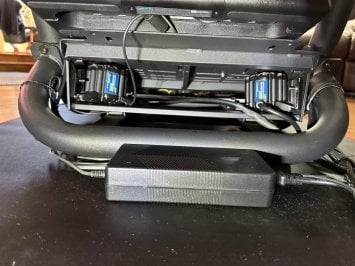Hi everyone,
I’m Johann, writing from Germany. I've built up a motion rig (NJMotion Compact-R, Logitech G-Pro, Buttkicker) and now I’m working on fine-tuning the technical setup between GT7 on PS5, SimTools, and SimHub. I was hoping to get some help here. I've tried a few steps with chatgpt, but I'm just going around in circles and not getting anywhere.
I’m currently trying to get Gran Turismo 7 (PS5) working with both:
My System
Motion works perfectly via SimTools on port 33740
The GT7 Plugin in SimTools receives XSim data fine
What doesn’t
I want SimHub to receive native GT7 telemetry data on a second port (34000), while SimTools keeps working on 33740.
I tried: python GT7Proxy.py --ps_ip 192.168.178.173 --xsimoutput 33740 --sendport 34000
But SimHub never receives anything.
Also, GT7Proxy shows the following error in the console:
Exception: unpack requires a buffer of 316 bytes
Even though GT7 is running and I’m actively driving.
Already tried:
Is there a way to make GT7Proxy send both:
Really appreciate any help or config suggestions – this is driving me nuts 😅
Thanks in advance!
I’m Johann, writing from Germany. I've built up a motion rig (NJMotion Compact-R, Logitech G-Pro, Buttkicker) and now I’m working on fine-tuning the technical setup between GT7 on PS5, SimTools, and SimHub. I was hoping to get some help here. I've tried a few steps with chatgpt, but I'm just going around in circles and not getting anywhere.
I’m currently trying to get Gran Turismo 7 (PS5) working with both:
- ✅ Motion via SimTools v3 (NJMotion Compact-R motion platform)
- ✅ Dashboards & bass shakers via SimHub v9.8.4
My System
- Game: GT7 on PS5
- Motion platform: NJMotion Compact-R
- SimTools v3 with GT7 plugin installed
- SimHub v9.8.4
- GT7Proxy (Python version 1.8.0)
- PC and PS5 are on the same wired LAN
- Windows 11, Python installed
- GT7Proxy receives data correctly using:
python GT7Proxy.py --ps_ip 192.168.178.173
Motion works perfectly via SimTools on port 33740
The GT7 Plugin in SimTools receives XSim data fine
What doesn’t
I want SimHub to receive native GT7 telemetry data on a second port (34000), while SimTools keeps working on 33740.
I tried: python GT7Proxy.py --ps_ip 192.168.178.173 --xsimoutput 33740 --sendport 34000
But SimHub never receives anything.
Also, GT7Proxy shows the following error in the console:
Exception: unpack requires a buffer of 316 bytes
Even though GT7 is running and I’m actively driving.
Already tried:
- Firewall ports 33740 and 34000 open
- SimHub listening on UDP 34000 (Live mode active, forwarding disabled)
- All tools started as admin
- PS5 reachable by ping
- I’m in an actual race (not in menu)
- Tried also --simhub_port and --format gt7 → not supported by my GT7Proxy build
Is there a way to make GT7Proxy send both:
- XSim to SimTools (33740)
- GT7-native format to SimHub (34000)
...at the same time? - Or a known working workaround?
Really appreciate any help or config suggestions – this is driving me nuts 😅
Thanks in advance!



